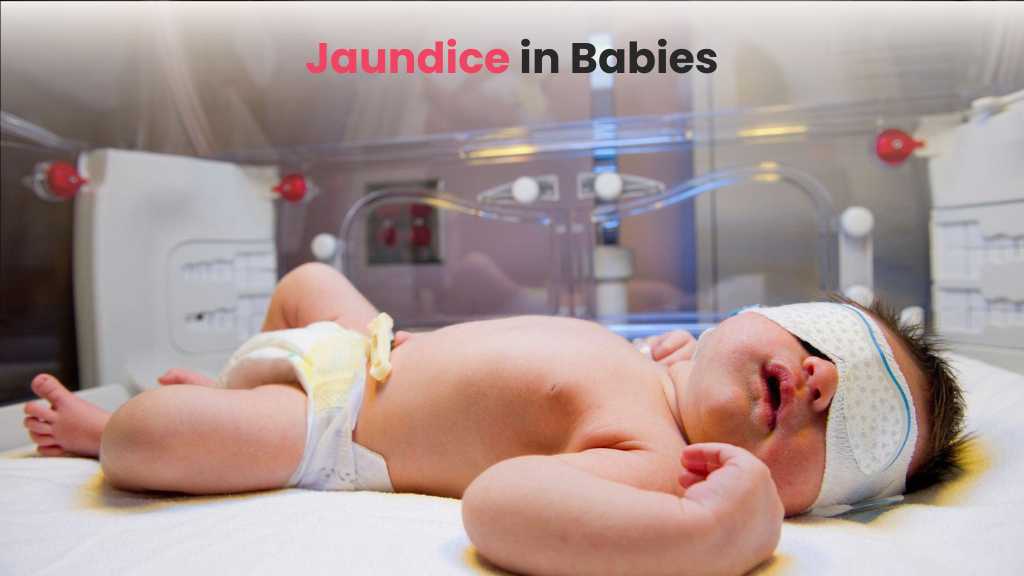
Table of Contents
Introduction
Jaundice in newborns is a common condition, affecting nearly 60% of full-term infants and 80% of premature babies. It occurs due to the accumulation of bilirubin, a yellow pigment produced during the normal breakdown of red blood cells. While jaundice is usually harmless, it is essential for parents and caregivers to understand its causes, signs, and levels to ensure timely and appropriate care for their newborns.
Causes of Jaundice in Newborns
What causes jaundice in newborns? Well, let’s find out from the pointers below!
- Physiological Jaundice: This is the most common type of jaundice in newborns and occurs due to the immature liver’s inability to process bilirubin efficiently.
- Breastfeeding Jaundice: Inadequate breastfeeding can lead to dehydration, causing jaundice. This condition is usually temporary and resolves with proper feeding.
- Breast Milk Jaundice: Some substances in breast milk can prevent the baby’s liver from processing bilirubin effectively. This type of jaundice might persist for a few weeks but is harmless.
- Blood Type Incompatibility: If the baby’s blood type is incompatible with the mother’s, it can lead to a rapid breakdown of red blood cells and subsequent jaundice.
- Infections: Certain infections, such as hepatitis or rubella, can cause jaundice in newborns.
Signs of Jaundice in Newborns
- Yellowing of Skin and Eyes: The most common sign of jaundice is the yellowing of the baby’s skin and the whites of their eyes.
- Poor Feeding or Lethargy: Jaundiced babies might become lethargic and have difficulty feeding due to the associated weakness.
- High-Pitched Crying: Some jaundiced babies might have a high-pitched cry, indicating discomfort.
- Dark Urine and Pale Stools: Jaundice can affect the color of urine and stools. The urine might appear dark, while the stools can become pale.
Jaundice Levels in Newborns and Monitoring
Jaundice levels in newborns are measured through a blood test that determines the concentration of bilirubin in the baby’s bloodstream. Doctors use these levels to assess the severity of jaundice and decide on the appropriate course of action.
- Mild Jaundice: Mild cases often resolve on their own with proper feeding and monitoring. The baby may be placed under special lights (phototherapy) to help break down bilirubin more quickly.
- Moderate Jaundice: Babies with moderate jaundice might require phototherapy and increased feeding frequency to help eliminate bilirubin from their system.
- Severe Jaundice: In severe cases, especially if the baby’s bilirubin levels are dangerously high, hospitalization and intensive phototherapy might be necessary. In extreme cases, an exchange transfusion, where the baby’s blood is replaced with donor blood, may be performed.
Diagnosis and Tests for Jaundice in Newborns
Diagnosing jaundice in newborns involves a combination of physical examination, assessment of medical history, and specific blood tests to measure bilirubin levels. Here’s a detailed overview of the diagnosis and tests used to identify and monitor jaundice in newborns:
Physical Examination: Healthcare providers conduct a visual inspection to detect yellowing of the baby’s skin and eyes. They assess the extent of jaundice and may use a handheld device called a transcutaneous bilirubinometer to measure bilirubin levels through the skin’s surface.
Medical History: Gathering information about the baby’s birth, feeding patterns, and any noticeable symptoms helps doctors understand the potential causes of jaundice. A family medical history might also be considered to rule out inherited conditions related to jaundice.
Blood Tests:
– Total Serum Bilirubin Test: This blood test measures the total amount of bilirubin in the baby’s bloodstream. Elevated bilirubin levels indicate jaundice. The results help determine the severity of jaundice and the appropriate treatment.
– Direct and Indirect Bilirubin Test: These tests differentiate between the types of bilirubin in the blood. Indirect bilirubin is the unconjugated form that rises in cases of excessive breakdown of red blood cells. Direct bilirubin is the conjugated form that increases when the liver is unable to process bilirubin effectively. Understanding these levels assists in diagnosing the underlying cause of jaundice.
– Complete Blood Count (CBC): CBC helps assess the overall health of the baby’s blood, including the number of red blood cells, white blood cells, and platelets. Abnormalities in the CBC results can provide additional insights into the cause of jaundice.
Reticulocyte Count: This test measures the number of young red blood cells in the bloodstream. Elevated reticulocyte count suggests increased red blood cell breakdown, contributing to jaundice.
Blood Type and Rh Factor: Determining the baby’s blood type and Rh factor is crucial, especially if jaundice is suspected due to blood type incompatibility between the baby and the mother.
Additional Tests (if necessary): Depending on the baby’s symptoms and medical history, healthcare providers may conduct additional tests to rule out specific conditions, such as genetic disorders or infections, which could be causing jaundice.
In summary, a combination of physical examination and blood tests, including total serum bilirubin, direct and indirect bilirubin, CBC, reticulocyte count, and blood type analysis, helps diagnose jaundice in newborns. Early and accurate diagnosis is essential to determine the severity of jaundice and initiate timely interventions, ensuring the baby receives appropriate care and treatment. Parents and caregivers should promptly seek medical attention if they notice any signs of jaundice in their newborns for proper evaluation and management.
Prevention of Newborn Jaundice
While not all cases of newborn jaundice can be prevented, there are certain measures that parents and healthcare providers can take to reduce the risk and severity of jaundice in newborns. Here are some preventive strategies:
- Prenatal Care: Adequate prenatal care is crucial. Mothers should attend all prenatal appointments, allowing healthcare providers to monitor the baby’s health and address any potential risk factors for jaundice.
- Blood Type and Rh Factor Testing: Blood type and Rh factor incompatibilities between the mother and baby can lead to jaundice. Identifying these incompatibilities early allows healthcare providers to take preventive measures.
- Proper Feeding: Ensuring proper and timely feeding is essential. Early and regular breastfeeding helps prevent dehydration and encourages frequent bowel movements, aiding in the elimination of bilirubin from the baby’s body.
- Monitoring: Healthcare providers should closely monitor newborns, especially those at higher risk, in the first few days after birth. Regular bilirubin level checks can help detect jaundice early, allowing for timely interventions.
- Supplemental Formula: If breastfeeding is challenging or if the baby is not getting enough milk, healthcare providers might recommend supplementing with formula to ensure the baby is adequately nourished, reducing the risk of jaundice due to insufficient feeding.
- Sunlight Exposure: In some cultures, exposure to natural sunlight is believed to help reduce jaundice. However, this should be done cautiously under healthcare provider guidance, as excessive sunlight exposure can harm the baby’s delicate skin.
- Avoidance of Unnecessary Interventions: Some interventions, like early cord clamping, might increase the risk of jaundice. Discuss birthing preferences with healthcare providers to ensure that interventions are medically necessary.
- Educating Parents: Providing education to parents about the signs and symptoms of jaundice, the importance of early feeding, and the significance of medical check-ups in the first few days after birth can empower them to detect issues early and seek timely medical assistance.
- Treating Underlying Conditions: If the mother has conditions like diabetes or certain infections, managing these conditions during pregnancy can minimize the risk of jaundice in the newborn.
In summary, while not all cases of newborn jaundice can be prevented, proactive prenatal care, proper feeding, regular monitoring, and educating parents are essential preventive measures. By identifying risk factors early and taking appropriate precautions, healthcare providers and parents can work together to minimize the impact of jaundice on newborns and ensure their well-being.
Signs of Recovery For Jaundice in Newborns!
Recovery from jaundice in newborns involves monitoring and ensuring that the baby’s bilirubin levels return to normal. Signs of recovery for jaundice in newborns typically include:
- Improved Skin Color: One of the first signs of recovery is the baby’s skin becoming less yellow. As bilirubin levels decrease, the yellow discoloration fades, starting from the face and then gradually moving down the body.
- Eating and Sleeping Patterns: A recovering newborn with jaundice will often show improved feeding habits and sleep patterns. As the baby starts feeling better, they may become more alert, active, and interested in feeding.
- Stool Color: Jaundiced babies often have yellowish stools. As they recover, their stool color will become more normal, indicating the body’s ability to process bilirubin effectively.
- Urine Color: Similarly, the color of urine changes when a newborn has jaundice. Dark yellow or orange urine is a common symptom. As recovery begins, the urine will become lighter in color.
- Energy Levels: Babies recovering from jaundice tend to become more energetic and responsive. They may start to show interest in their surroundings and interact more with caregivers.
- Weight Gain: Adequate feeding is crucial during recovery. A sign of recovery is steady weight gain, indicating that the baby is receiving enough nutrition and is on the path to health.
- Normal Bilirubin Levels: The most definitive sign of recovery is a decline in bilirubin levels within the baby’s blood, confirmed through blood tests. Healthcare providers closely monitor these levels to ensure they are within the safe range.
It’s important for parents to follow medical advice, attend follow-up appointments, and provide proper feeding and care to support the baby’s recovery from jaundice. Always consult a healthcare professional if you have concerns about your newborn’s health.
Conclusion
Jaundice in newborns is a common and usually harmless condition. However, it is crucial for parents and caregivers to be aware of the signs and levels of jaundice to ensure early detection and appropriate management. Regular check-ups with healthcare providers, especially in the first few weeks of a baby’s life, can help monitor jaundice levels and provide necessary interventions if required. With proper care and attention, most cases of newborn jaundice can be effectively managed, ensuring the health and well-being of the baby.










